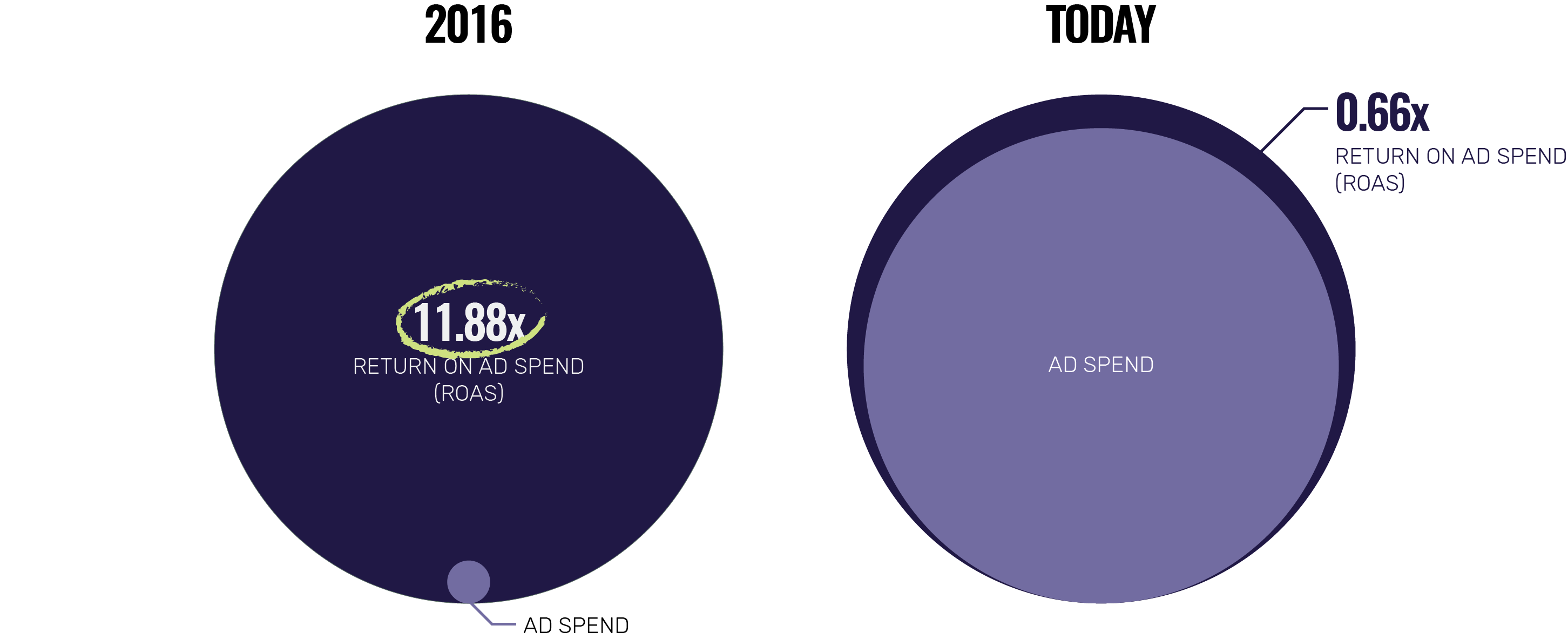Part 3 (of 6): The Math Doesn’t Add Up
Why Traditional “Bro-Marketing” Principles Kill Your Facebook Ad Results
Part (2 of 6): The Rise of Bro-Marketing
- Our industry was built by “Bro-Marketers”. And their egocentric sales ethos has infiltrated and impacted the way we do business online. And not in a good way.
- It's not your fault that your Facebook ads aren't working.
T he strongest argument against Bro-Marketing is the math itself.
And honestly, that’s what I love about Facebook advertising and conversion-style marketing in general:
Click to TweetAt the end of the day, the numbers call the shots. Numbers tell us what’s working, what’s failing, and what’s about to implode.
Let’s look at the stats.
The “unabridged numbers” seen from behind-the-scenes of not just one but multiple businesses spanning an entire industry, a vantage point unique to people like me—consultants and service providers, tell us the whole story…
…and predict either scalable profitability OR pending doom.
These numbers are what first alerted me to the deeper problems with Bro-Marketing – the ones that aren’t quite so visible at first glance to an individual business owner.
1. Bro-Marketing and the “lowest common denominator”
In the Facebook ads space, there’s this tunnel-vision focus on scarcity metrics, like cost-per-lead and cost-per-click.
Marketers treating their potential customers like they’re running numbers through a selling machine—competing on pure volume—“dumping” them like crabs into a bucket.
The problem is their selling machine is full of holes. So, for every 100 people dumped into the top of the funnel…99 fall out the cracks.
It’s a classic case of a “leaky bucket” business.
You constantly need more people to replace the leads you’re losing every day.
More, more, more.
And this dangerous focus on quantity over quality becomes the key failure point when you’re at the mercy of Facebook. * Ahem *… running Facebook ads.
When CPMs rise, your lead costs skyrocket. So, in desperation, you look for the hacks, tactics, and general Bro-Marketer shortcuts to get attention at all costs since you need such a large quantity of leads to generate a single sale.
It’s a vicious cycle.
When optimizing for these front-end metrics, you take your eye off the real target: increasing earnings-per-lead by creating real transformation in the lives of your customers and fuelling an ever-growing customer Lifetime Value (LTV).
Long story short, white-knuckle focus on cheap lead gen sabotages the rest of your sales process from the very beginning.
2. Bro-Marketing and the normalization of basement-level conversion rates
Recently, I was privy to a conversation between some big name experts talking about sales page conversion rates. Their goal? 1-3% sales conversions.
This is why marketers obsess over lead costs.
Click to TweetThey’re paying for one hundred (expensive) leads and only ever converting one of them.
No one’s asking why 99 people opt-in to hear about what you do…and then change their mind by the time they reach the end of your funnel.
Again, at the risk of sounding like a broken record, this resignation is a direct result of drinking from the polluted pond of Bro-Marketing. We’ve accepted basement-level conversion rates, and ignored the 99%, because that’s “just the way it is.”

People are raising questions now because the costly symptoms are finally showing up.
It reminds me of Erin Brockovich and the contaminated groundwater debacle in Hinkley, California. For four decades, PG&E dumped chemical waste in the area—but no one raised questions until years later, when clustered cancer cases appeared.
Problems are rarely identified or taken seriously until the symptoms of living with them become costly enough.
And that’s why people are finally asking questions about the profitability and sustainability of Facebook ads.
Because the standard conversion percentage math isn’t working anymore (and there’s a reason why).
Travis Sago says it better than I do:
Ask a salesperson or funnel expert where you "lose" most sales and they'll tell you "at the end."
The million dollar reality is...
You lose most of your sales at THE BEGINNING.
The problem isn't the small conversion at the END of your funnel, it's paying for (in time, money or energy) and letting the wrong people in at the beginning of your funnel which is setting a torch to your cash.
Read the rest of his eye-opening conversion breakdown here. It’s not long, and it’ll be more than worth your time.
And then, if you want to understand the critical danger of accepting low conversion rates (and if you like fired-up rants as much as I think you do), read this short post.
So, why aren’t the status quo funnels and ad campaigns working anymore?
A couple reasons. The simplest being that “blunt force marketing has a very short half-life”, as Andre Chaperon* says.
* If you end up purchasing the L-E-G-E-N-D-A-R-Y Sphere of Influence (SOI) via the link above —which this entire article flow is based upon—André will graciously send me a ‘thanks for the intro' cheque which fuels these 4-shot latte fuelled internet musings at no additional cost to you.
The twist-your-arm tactics stop working, and the market begins to wise up to the transactional nature of the funnel system.
Add that to saturation and an increasing number of advertisers on the platform. The level of NOISE on Facebook (and in general) has grown exponentially and unsustainably. In 2011, there were two people yelling about internet marketing tactics. Now there are two thousand—all vying for the same ad space, the same eyeballs, and the same wallets.
And, of course, all the people that have tried to game the system with Spammy McMarketson hacks are now getting played by an algorithm that’s getting smarter by the day.
The data doesn’t lie, people.
3. Bro-Marketing and the myth of revenue-driven marketing
You can’t open Facebook without being bombarded by someone’s income report, revenue numbers, or new launch record. It’s compelling. It’s addictive. It’s sexy.
But it’s all just vanity metrics.
Someone once asked Jeff Moore about the biggest business lie he’d ever been told.
He said: “If you can spend 50 bucks to make 100 bucks, you have a thriving business.”
Why is this such a problematic myth?
Because you don’t have a thriving business if it costs you $51 or more to fulfill on that sale.
- A 7-figure launch is meaningless when you spent $950k on ads.
- A $10K deal is nothing when you’ll have to shell out $9500 to your team.
- A record month is meaningless if you can barely cover your overhead.
If you want to see a truly brilliant entrepreneur break down REAL profitability (and the investigation that ended in him closing a $2MM product), you need to read this. Ramit Sethi owns his ish more than almost anyone else in this online space, and “eavesdropping” on his gut-wrenching decision to kill a multi-million dollar program is super eye-opening.
Let’s look at an example for a minute. Watch what happens when you optimize for lead costs and aren’t able to control the profitability of the rest of your funnel.
In 2016, a friend of mine started running paid traffic to a $297 offer.
For a while, everything went swimmingly well.
100 leads @ $1.50 = $150
100 leads @ 6% conversion = 6 sales = $1,782
Revenue – Ad Spend = $1,632
Return on Ad Spend (ROAS) = 11.88x
Today, they’re STILL fighting to optimize for cost per lead (CPL), but everything’s changed—and now they’re losing money.
Today’s results:
100 leads @ $4.50 = $450
100 leads @ 1% conversion = 1 sale = $297
Revenue – Ad spend = $153 loss
Return on Ad Spend (ROAS) = 0.66x
Moral of the story?
When lead costs and CPMs rise, you must have a strategy in place to maximize profitability and maintain consistent conversion rates.
And if you don’t have a system for making that happen like clockwork?
Your days of success on Facebook are numbered, my friend.
“When the facts change, I change my mind. What do you do, sir?” – Winston Churchill
So, this all begs the question:
Are Facebook Ads dying?
Is digital marketing dead?
Is paid traffic a fool’s errand?
I don’t think so.
And I have thousands of data points, hundreds of documented campaigns, and dozens of case studies to prove my point (you’ll see them in a minute).
But I’ll tell you what’s dying.
- Bro-Marketing.
- Set-it-and-forget-it webinars.
- Sleazy lead gen tactics.
- Sales first, clients second.
- Funnel hacking.
- Race-to-the-bottom lead gen.
A shift is coming. People aren’t going to tolerate B.S. training and B.S. results much longer.
Especially when there’s a different way to run paid traffic—a way that honours profitability, honours customers, and honours your own freaking morals.
The only catch?
For this new approach to make sense, you have to take the word “funnel” out of your vocabulary.
Because if you’re still thinking in terms of funnels, you won’t be able to make this method work. They’re completely incongruent.
But if you’re able to adopt the new paradigm that I’m about to show you, it will change everything for you: your ads, your sales process, your results, your client relationships, and your business.
It will change all of that—forever.
Subtext
- The shortcut sales hacks that used to work aren’t working anymore. And we need more than a bandaid.
- Bro-Marketing is dying—because it markets to the lowest common denominator, it settles for basement-level conversion rates, and it focuses on revenue over profit.
- Facebook ads AREN’T dying…but they’re about to stop working for anyone who relies on hard-core lead gen funnels.
Intrigued by the psychology behind what you're reading? It's called a Multi-Page Presell Site (or, MPPS for short) and coined by the dark horse of internet marketing, André Chaperon. (Seriously, the guy basically lives off-grid in freaking Gibraltar and is never seen on social media.)
He's the man I credit as one of my personal marketing mentors and the king of empathy-driven marketing.







